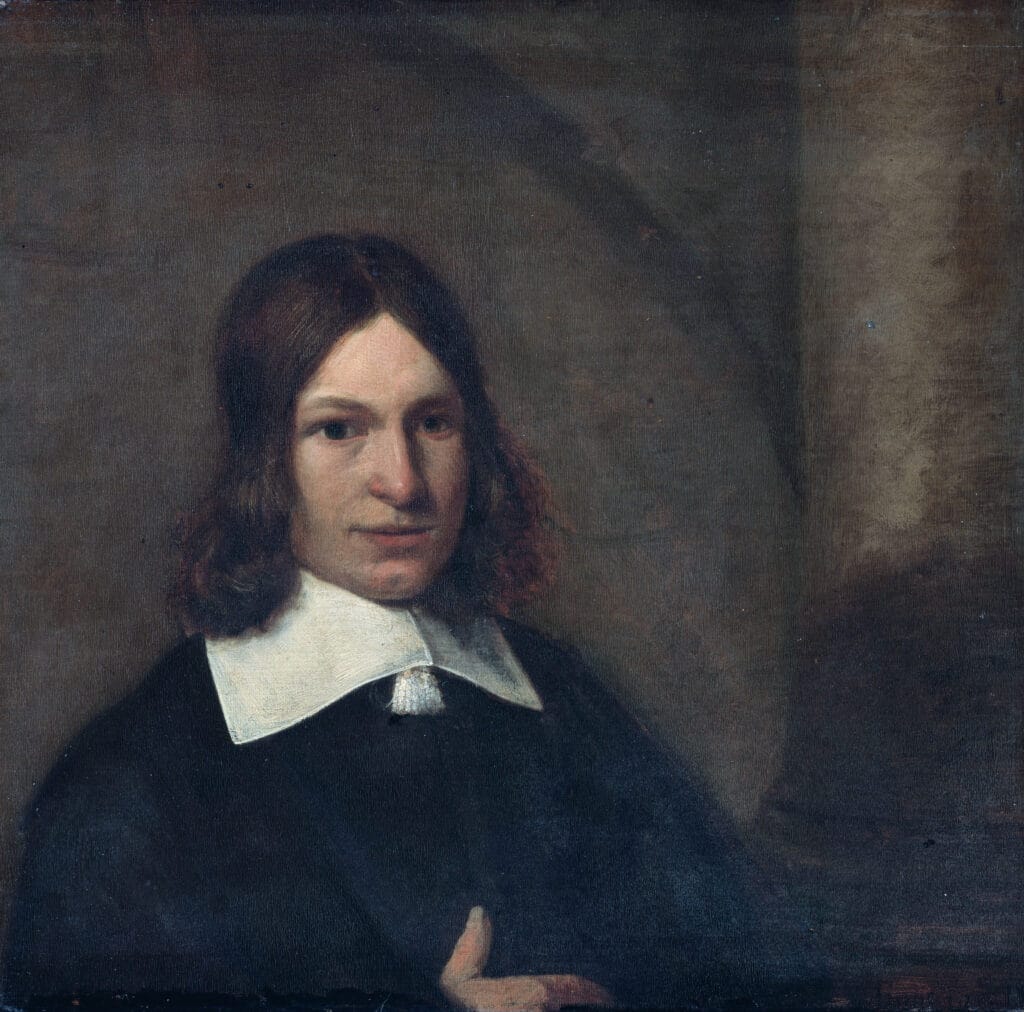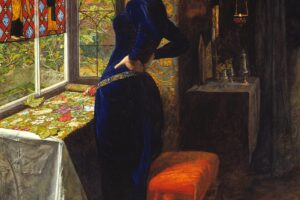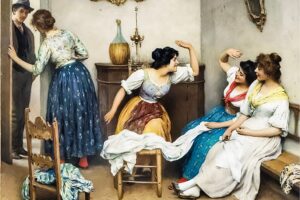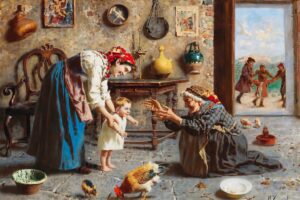By Pieter de Hooch c. 1670–1674.
A Still Moment in Thread and Ink
In the quiet elegance of 17th-century Delft, Pieter de Hooch captured life’s simplest moments with reverence and grace. This scene, Interior with a Man Reading a Letter and a Woman Sewing, painted between 1670 and 1674, brings us into a modest Dutch home at a moment when time seems to pause—thread in one hand, a letter in the other, and the light gently pooling on the checkered floor.
The Scene Before Us
We step into a sunlit room where two figures sit in peaceful proximity: a man, hat still on, reads aloud from a letter; a woman in a rich red bodice and golden skirt listens while her hands rest atop a piece of white cloth, sewing basket beside her. Her posture is calm, her gaze soft, suggesting patience or familiarity. The black-and-white tiled floor, a staple of Dutch domestic interiors, leads us toward them, while warm light spills across the walls, highlighting every fold of fabric, every gesture.
Behind them, a quiet harmony reigns: a wall painting of Madonna and Child hangs above the fireplace, a landscape painting to the left mirrors the serenity of the moment. The perspective is exact, the space geometrically sound, yet the atmosphere is far from stiff—it breathes with life and light.
The Deeper Meaning
This is more than a household chore and a simple letter—it’s a study in rhythm and companionship. The letter may be from a relative, a friend, or even a suitor; we do not know. But the intimacy of the moment transcends words. De Hooch, like his contemporary Vermeer, paints not just what people do, but how they exist in relation to each other. The quiet symmetry between the man’s reading and the woman’s sewing suggests a shared life—a domestic balance.
We are also witnessing a meditation on time. The tasks are everyday ones, yet they hold stillness and meaning. The painting honors the value in repetition, in waiting, in listening. Through light, line, and silence, de Hooch reminds us that even small acts—reading aloud, mending cloth—can become gestures of care and connection.
A Moment Caught in Time
Pieter de Hooch’s interiors are never just about rooms—they are about the lives lived inside them. In this painting, the physical space becomes a sanctuary. We’re drawn not by drama, but by trust. There is no rush, no spectacle, only the quiet partnership of two people and the warmth of domestic order.
We may leave this painting with no answers—what did the letter say? Did she respond? But its gift is subtler: it invites us to reflect on our own small rituals, the ways we communicate without urgency, and the beauty found in an ordinary afternoon.
About Artist

Pieter de Hooch (1629–1684) was a Dutch Golden Age painter renowned for his serene genre paintings of domestic life and courtyards. He was a contemporary and peer of Johannes Vermeer in Delft, and their work shares a similar focus on light, perspective, and the quiet dignity of everyday scenes. However, unlike Vermeer, de Hooch often created more complex spatial compositions, using a series of rooms, open doors, and windows to lead the viewer’s eye deep into the scene
Artistic Style
De Hooch’s signature style is defined by his masterful handling of perspective and light. He used architectural elements like checkerboard tile floors and open doorways to create a convincing sense of depth, pulling the viewer into the painting. He was particularly skilled at capturing the effects of natural light as it filtered from one room to another, or from a sunny courtyard into a dim interior. His works often feature a sense of calm and order, a reflection of the Dutch middle-class values of the time.
Notable Works
- “The Courtyard of a House in Delft” (1658): One of his most famous paintings, this work showcases his ability to depict a complex, sun-drenched architectural space. The meticulously rendered brickwork and warm light create a feeling of peace and well-being.
- “The Mother” (c. 1660): This intimate painting captures a quiet moment of domestic bliss, with a mother seated by her child’s cradle in a sunlit room. It exemplifies de Hooch’s focus on the simple, yet profound, beauty of family life.
- “Interior with a Man Reading a Letter and a Woman Sewing” (c. 1664-1666): This painting is a quintessential example of his mature work. It features a woman in a bright red jacket seated, sewing in a sunlit corner of a room, while a man in the shadows to the left reads a letter. The strong contrast between the light on the woman and the shadow on the man creates a sense of intimacy and emotional connection. The careful arrangement of the room and the subtle play of light demonstrate his skill in transforming a simple domestic scene into a captivating work of art.



